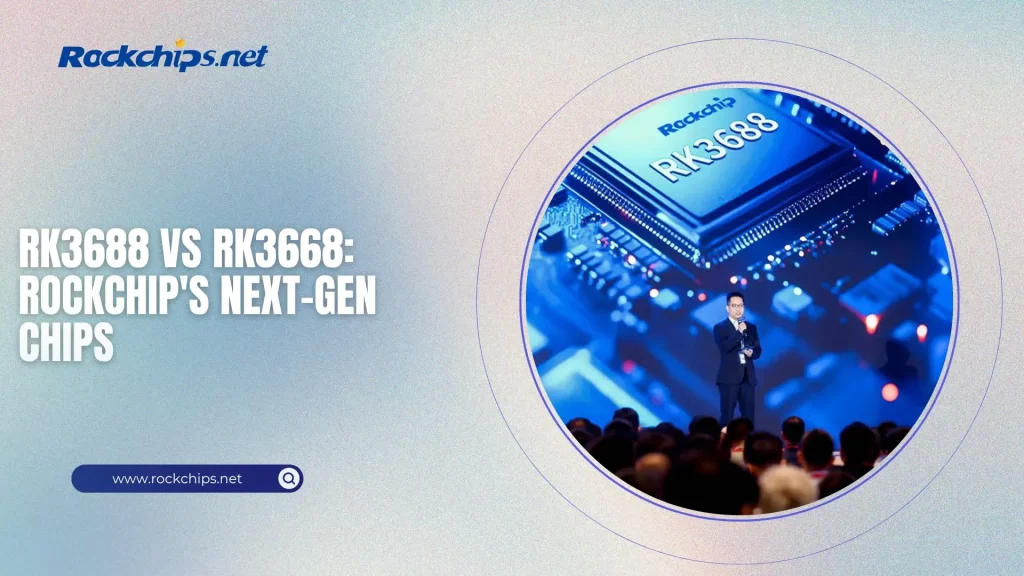
Rockchip has once again raised the bar for ARM-based processors with its upcoming RK3688 and RK3668 chips. It will be a chip with high computing performance. As the successor to the popular RK3588 series, the RK3688 will be a new leader with 12 CPU cores and 32 TOPS NPU performance, while the RK3668 offers a more cost-effective 10-core alternative.
Technical Specifications
The Rockchip chips, RK3688 and RK3668, are a big step forward in ARM processor technology. They have new CPU designs and special hardware to do AI tasks. These chips can compete with top products from Qualcomm, MediaTek, and NVIDIA.
CPU Configuration and Performance
RK3688 features an impressive 12-core CPU configuration combining ARM’s latest Cortex-A730 and Cortex A530 cores in a big.LITTLE arrangement.
- 8 performance cores (Cortex-A730) for demanding compute tasks
- 4 efficiency cores (Cortex-A530) for background operations
- Dynamic frequency scaling across all cores
- Advanced branch prediction and out-of-order execution
The RK3668 has a slightly changed processor with 10 cores: 4 Cortex-A730 and 6 Cortex-A530. This setup uses less power and is good for tasks that don’t need a lot of CPU power. Both chips are made with a modern manufacturing process, probably 4nm or similar.
GPU and AI
The latest processors are designed with a strong focus on graphics and artificial intelligence capabilities. For instance, the RK3688 features an ARM Mali GPU capable of reaching up to 2 TFLOPS of computing power. RK3668 offers between 1 and 1.5 TFLOPS, depending on its configuration. Both chips are also equipped with Rockchip’s newest RKNN-P3 neural processing unit, enhancing their AI processing performance.
- RK3688: 32 TOPS (Trillions of Operations Per Second)
- RK3668: 16 TOPS
- Support for INT4, INT8, INT16, and FP16 precision
- Hardware acceleration for common AI frameworks
This substantial AI performance boost specifically targets emerging AIoT applications, from smart cameras to industrial automation systems.
Memory and I/O Capabilities
Memory bandwidth frequently limits the performance of high-end systems. To address this, Rockchip has outfitted their processors with advanced memory controllers.
| Feature | Rockchip RK3688 | Rockchip RK3668 |
|---|---|---|
| CPU | 8 x ARM Cortex-A730 4 x ARM Cortex-A530 | 4 x ARM Cortex-A730 6 x ARM Cortex-A530 |
| GPU | ARM Mali 2 TFLOPS | ARM Mali 1 to 1.5 TFLOPS |
| NPU | RKNN-P3 32 TOPS | RKNN-P3 16 TOPS |
| Memory | LPDDR5/6 200 GB/s bandwidth | LPDDR5/6 100 GB/s bandwidth |
Target Applications and Market Positioning
Rockchip is carefully positioning the RK3688 and RK3668 at the crossroads of several rapidly expanding technology markets. While still compatible with traditional single-board computer applications, these processors offer new capabilities that unlock a host of possibilities for developers and manufacturers alike.
AIoT and Edge Computing
Both chips are good for AI tasks. The RK3688 can do a lot of work quickly and watch many videos at once. The RK3668 costs less and is better if you want to save money. You can use them for various projects.
- Smart city infrastructure (traffic monitoring, crowd analysis)
- Industrial quality control systems
- Autonomous mobile robots
- Advanced driver assistance systems (ADAS)
Rockchip supports both LPDDR5 and LPDDR6 memory options. This gives makers more choices to make devices cheaper or faster. The RK3688 has a strong 200GB/s speed, which helps it work well with the fast NPU and GPU parts.
High-End Multimedia and Display Capabilities
Both processors support 8K/60fps video encoding and decoding, along with HDMI 2.1 output. This makes them strong candidates for:
- Digital signage solutions
- Media playback devices
- Video conferencing systems
- Professional AV equipment
The inclusion of UFS 4.0 storage support ensures that storage bandwidth won’t bottleneck these multimedia applications, while PCIe and UCIe interfaces provide expansion capabilities for additional peripherals or accelerators.
Comparison with Previous Generation RK3588
Although Rockchip hasn’t published detailed benchmarks comparing the RK3688/RK3668 to their previous model, the enhancements in its architecture indicate significant performance improvements.
- 50-100% more CPU cores compared to RK3588’s octa-core design
- 2-4x improvement in NPU performance
- Support for newer memory standards (LPDDR6 vs LPDDR4/5)
- Enhanced video codec support
These improvements come at the cost of likely higher power consumption, though Rockchip’s implementation of the ARM cores and process node selection should help maintain reasonable efficiency.
As Rockchip continually improves its processor lineup, models like the RK3688 and RK3668 showcase the company’s dedication to competing at the top of ARM-based computing. Developers eager to learn more should keep an eye on Rockchip’s product page for updates, while those seeking background information can reference this conference announcement.